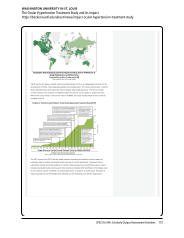SPEC Kit 346: Scholarly Output Assessment Activities · 53
Establish baseline service expectations for both subject liaisons and front-line staff. Create informational pages and
training to help get all staff up to speed.
Existing roles and skills of librarians can transfer into scholarly output assessment activities with training and education.
Faculty advocates have a stronger voice in describing the value of these services than library employees.
Focus on established data that faculty are familiar with rather than new social media metrics (almetrics) out there.
Get campus-wide input on the definition of the problem and selection of the tool.
Hire someone with expertise in this area.
Identify user needs. Provide time for staff to learn to do this. Get faculty input to plan programs; we need to understand
their needs. Lesson learned: We think that “we” know scholarly communication and how output assessment will
benefit faculty. But the big reveal was learning how competitive forces underlie faculty decisions on everything related
to scholarly output. They think much differently than librarians.
Integrate this work into existing relationships with faculty to support their work across the research life cycle.
It is challenging and time consuming to stay abreast of the tools and methods used to assess scholarly output. We
find that having a core group of librarians acquiring more in-depth knowledge in the area enables others to refer more
advanced questions to assist our user population.
It is critical to have the support of the high administration; most of these issues are related to institutional repository and
open access. We succeeded in presenting scholarly communication as part of a large “research life cycle” issue/project.
It is helpful to have a dedicated position or at least one faculty member who keeps abreast of emerging products and
resources and then provides staff development for other faculty and staff.
It’s important to get faculty buy-in by making the workflow for assessing and tracking scholarly output as easy and
pain-free as possible.
It’s very important to understand campus culture and specific researcher or administrative needs in order to have
productive conversations.
Liaison model provides expert consultative services for unique concerns for each field as augmented by functional
experts support.
Make it extremely easy for the scholar. Any additional effort, no matter how slight, will be met with resistance. For this
reason, one must do just about all the work on behalf of the researcher. That means ultimately redeploying library staff.
Need to get other departments on campus involved in order to be successful.
None at this time.
Our institutional repository collection administrators really appreciate the regular email updates with usage statistics on
their collections.
Our librarians do not recommend Google Scholar. To researchers who use Google Scholar, our librarians recommend
other options such as Journal Citation Reports, Scopus, and Web of Science. While our librarians can provide reports
and guide researchers in scholarly output assessment, it is easier to let researchers review citations of their works
and correct inaccuracies. For example, it is not rare for a researcher to have multiple researcher profiles due to name
changes. Researchers should be responsible to reconcile their multiple researcher profiles and citations. We need
to remember that disciplinary differences in publishing cycles affect scholarly output, and that scholarly output of




























































































































































































